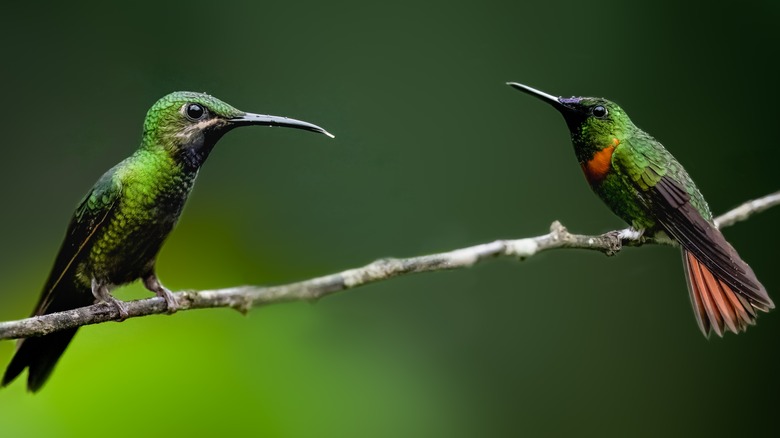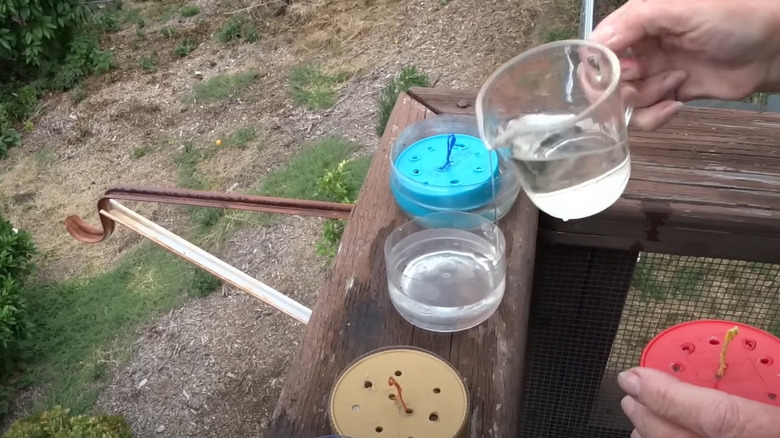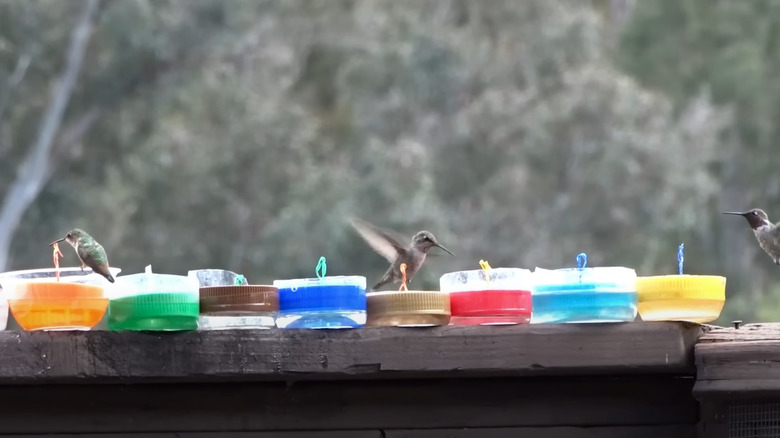The Budget-Friendly Hummingbird Feeder You Can DIY By Reusing A Pantry Staple
Hummingbirds bring a buzz of energy to yards as they flit about like living jewels. Their wings flutter so fast they hum, and it's pure magic to watch. They're also great at pollinating the fruit-bearing green companions in our outdoor spaces. Because of these reasons, you may be looking for ways to attract hummingbirds to your garden, and fortunately, doing so doesn't require dropping some serious cash on fancy feeders. For this hack, all you need is that clean, empty peanut butter jar you've been wondering what to do with. You'll cut the jar down to a smaller size, fill it with nectar, punch holes in the lid, and attach them together.
By repurposing a peanut butter jar into a hummingbird feeder, you're choosing the path less littered, one that champions conservation over convenience. After all, aren't you willing to go the extra mile to craft an oasis that lures feathered friends closer to your doorstep? And it costs you just about nothing, making it a great budget-friendly hack.
But let's say your kitchen is all out of peanut butter jars. No worries! It's the kind of thing you could borrow from your neighbor without a smidge of embarrassment. You could also search for another similar plastic jar in your pantry, like one for another type of butter or spread. However, keep in mind that we're only talking about plastic jars here, as glass ones are a bit too tricky to tinker with.
How to make a hummingbird feeder out of a peanut butter jar
For this easy DIY hummingbird feeder project, you'll need a bit of wire, the peanut butter jar, and a soldering iron if you've got one (though you could use scissors instead). Begin by popping two holes in the middle of the jar's lid using your soldering iron or the tip of sharp scissors. Then, scatter a few more holes around the edges. Ensure they're not too tiny but not gigantic either — think "just right" for those tiny hummingbird beaks.
Next, you'll cut the jar horizontally, leaving about an inch and a half of the jar attached to the base. You can do this with scissors or a knife. A hot soldering iron works too, but fair warning, it might leave a bit of a bulky edge. Discard the top, then give the bottom half and the lid a good scrub and a quick dry. After which, slide a wire through those two middle holes on the lid and twist it underneath the lid to make a handle.
Then, see if the lid can fit into the bottom of the jar. If things are a bit off, just make small slits on the bottom half's edge for a bit of give. Once you pop the lid snugly inside, all that's left is to pour in nectar. Finally, hang your homemade feeder in a prime location for watching those fluttering beauties do their thing.
Extra considerations for your DIY hummingbird feeder
According to a 2014 article published in The Condor, hundreds of millions of birds die annually from smacking into window glass. So, let's not tempt fate by placing your hummingbird feeder too close to the deceptive glass panes. What's the secret to picking that spot-on location, then? Think next to bushes and trees — they're prime pit stops and hideaways for our fluttery friends, especially when predators like Cooper's hawks swoop in for an unwelcome visit.
Further, to turn your feeder into the hottest ticket in town for hummingbirds, you need to paint it the right color. These flying wonders have got a thing for red, so slap some red paint on the lid or jazz up your feeder with red ribbons. If you're aiming for that natural and rustic vibe, get creative with dry leaves and twigs. To keep your hummingbird feeder cool in hot weather, place it in a shadowy spot, swathe it in aluminum foil, or set up a small fan nearby.
Regarding filling up your feeder, grabbing a ready-to-go option such as the Pennington Clear Nectar which costs less than $6 at Walmart isn't a bad move. But why not whip up your own sweet stuff? All it takes is 4 cups of hot water and 1 cup of white sugar. Stay clear of brown sugar, though — it's got iron-laden molasses that isn't great for hummingbirds. Finally, keeping the nectar fresh and the feeder squeaky clean will thwart mold growth.



